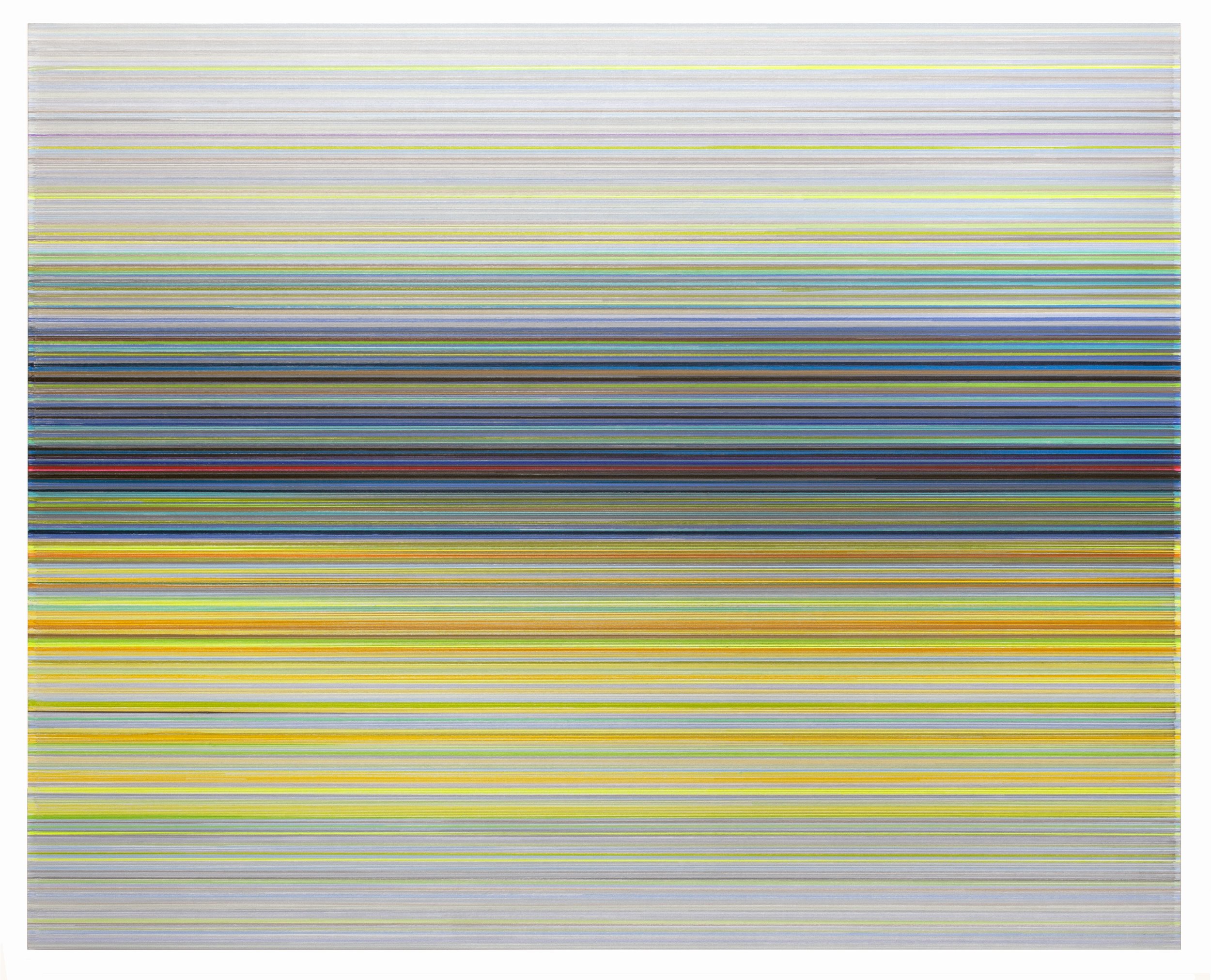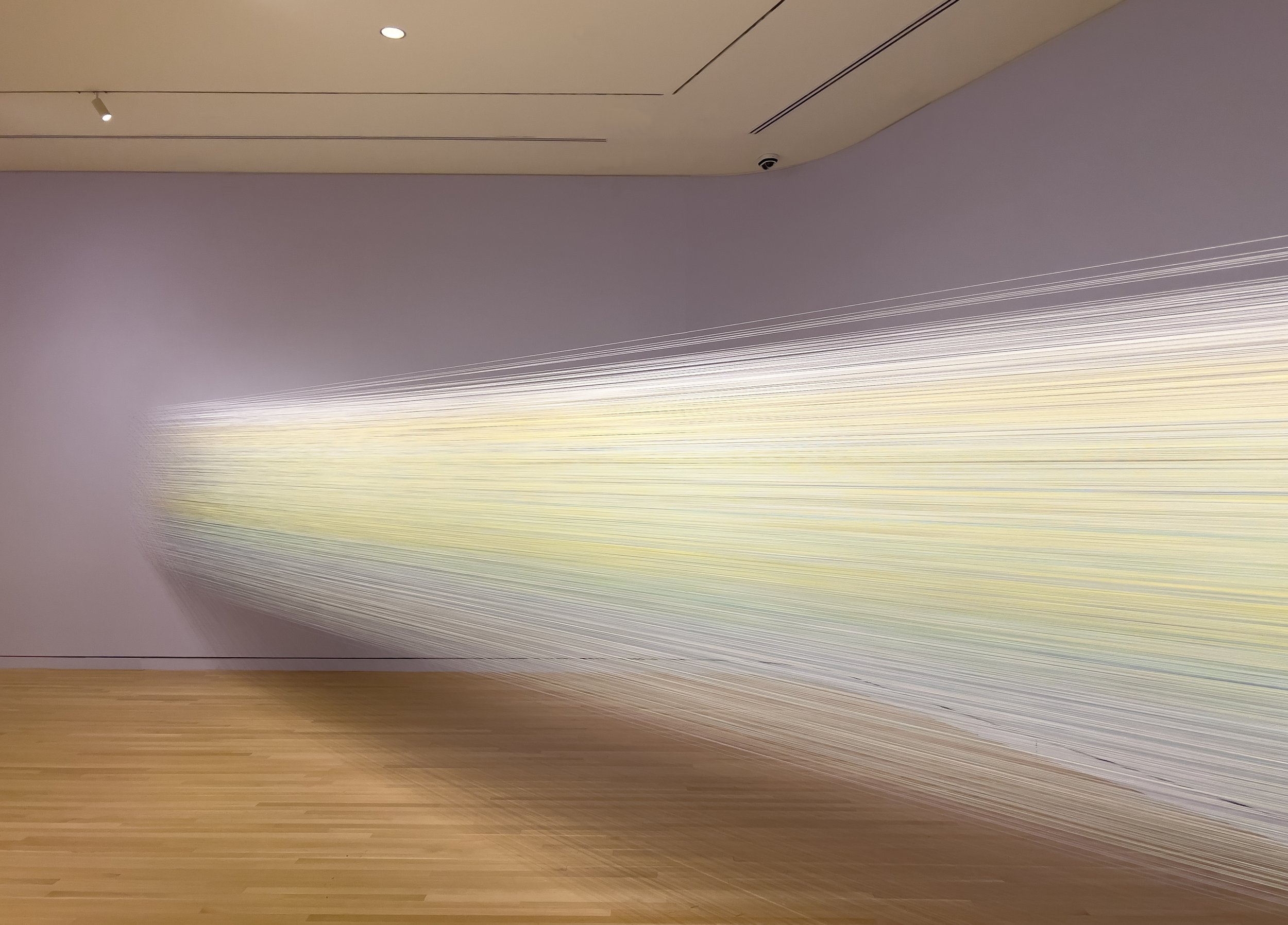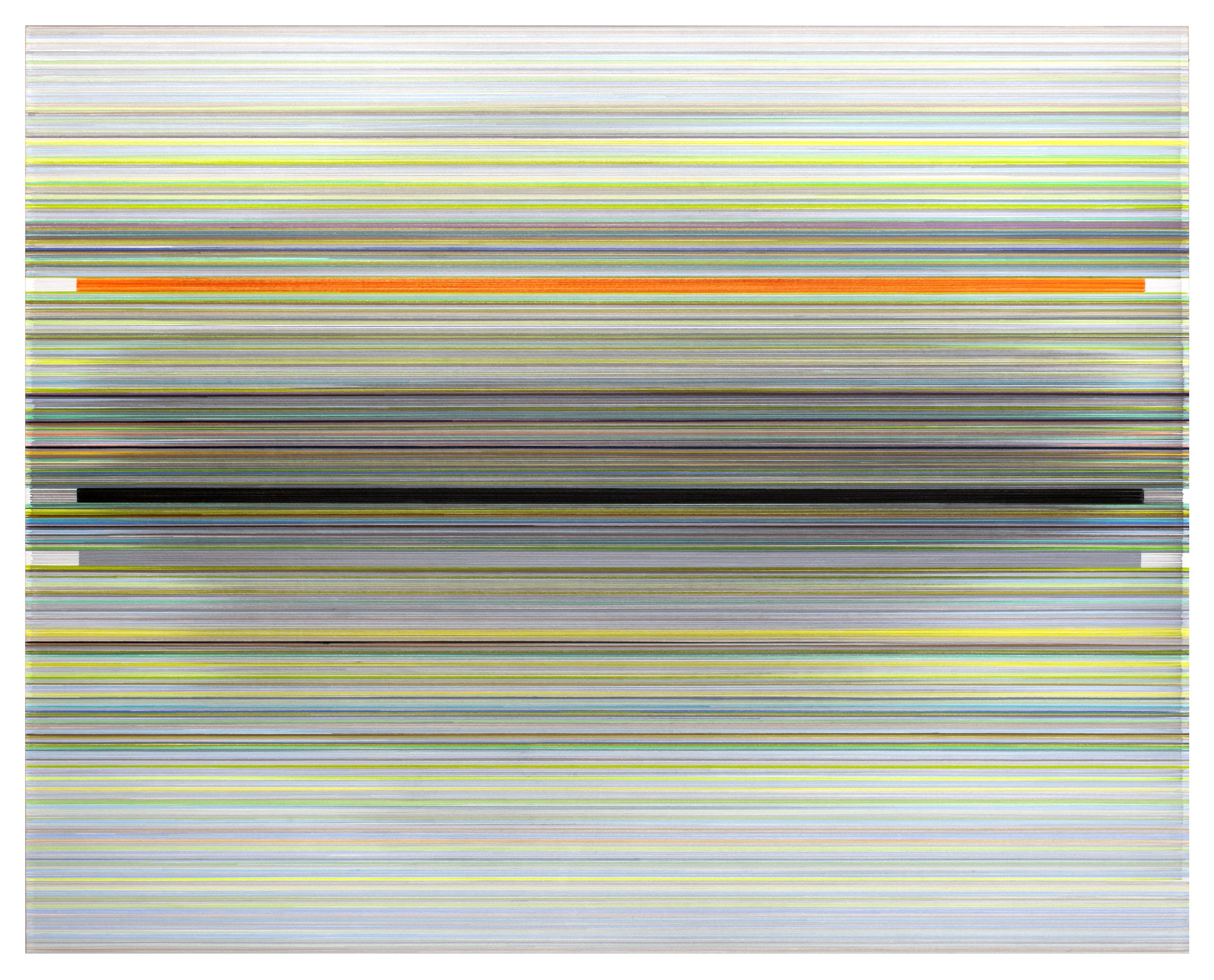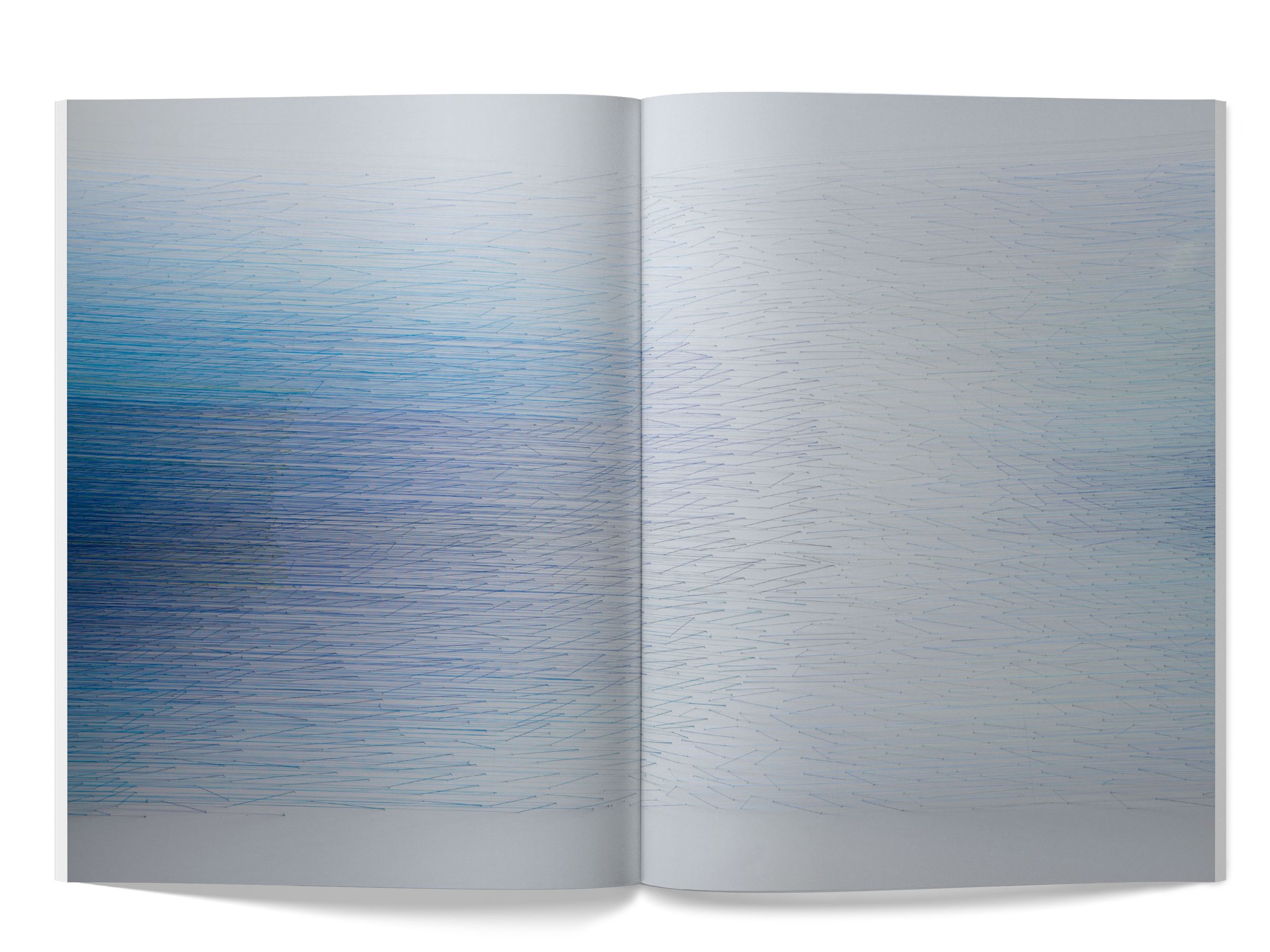Jane Bustin
Anne Lindberg
Of Waves
SEPTEMBER gallery
4 Hudson Street #3
Kinderhook, NY 12106
Jane Bustin and Anne Lindberg
October 28 - December 17, 2023
Here are things we can hold in our hands - a book, a page, a pencil - and things we cannot hold - a moment, a memory, a breath. We can gather the things themselves, touch them, see their evidence of time in salt stains and lost threads. We can hold an image of a sunset between thin lines and bright blues. Sometimes though it’s the spaces between absence and articulation - a lighter touch, an unmarked surface, a soft reflection - that opens us outwards. We can catch, sort and place, but it’s the thing we can’t contain, the spilling over, that leads us to a kind of surrender. And this is when we finally hush, and just float here.
We are thrilled to present a two person exhibition, Of Waves, with London based Jane Bustin, and Hudson Valley based Anne Lindberg. Each artist will have a room of their own, Bustin in the South gallery and Lindberg in the North gallery, with their works meeting in the center.
Both artists are working with the parameters of their own bodies, that is, Bustin works in parts that are scaled to hand-held proportions, while Lindberg works in a size that is an extension of arms reach. Light plays an important role, either suggesting an internal glow or literally reflecting from a surface. Both pull from written language, and specifically for this show, they draw inspiration from Virginia Woolf. Thinking about her novel, The Waves, Lindberg and Bustin make choices of palette, line and material. Their practices mirror the contemplative interiority of a poet, here finding form through a tenderly woven visual language.
Lindberg works with pencil, beginning with graphite and methodically layering with varying pressure of line. Her process contains instructions: draw straight lines side to side with the support of a ruler, graphite first, color on top. However, her process is also searching as she makes choices, changes pencils and colors or adjusts pressure along the way. For this body of work, Lindberg draws with a horizontal gesture, suggesting an expanse with orbs that hover, perhaps the rising sun or ripples of cloth, perhaps an apparition in fog. Along with her works on paper, Lindberg is presenting an installation made with blue, gray and white thread that itself becomes a horizon as the viewer gazes over the hovering form stretching between two walls.
Bustin is working with a carefully selected combination of materials - aluminum, copper, cloth and paper, each its own panel, positioned together in a grid of four. The cut sail cloth has been stained and worn by the English sea, creating indigo edges and loose threads. The paper has been culled from old books, their edges stained by time and sun, each page dipped in tea. The copper and aluminum reflect light, the context of a room, passing subjects. For this series of works, Bustin has spent hours at the British Library pouring through letters written between Virginia Woolf and her friends and lovers. Each grouping of four panels has been created as a poetic embodiment of their exchange, their relationship as conveyed through private letters, linked sentiments.
The repetition of line, materials, and form in both artists' works speak to one another, sharing language, forming overlap and connection. Ephemerality and temporality are reverberating throughlines. The constant here, like Woolf’s belief in the movement of language, is change.
Jane Bustin, born 1964, London, studied at Portsmouth University and lives and works in London, her practice spans three decades of single works in painting and ceramic as well as installation, text, film and performance. The paintings are made as sequential, monochrome abstract works, executed in a variety of mediums and surfaces. They explore the metaphysical potential for painting to 'make visual' philosophical concepts found primarily in modernist literature, feminism, theology as well as music and dance. The work is usually project based and can incorporate paintings, ceramic objects, text and live performance. The works influences come from 14th century frescos, 17th century painting, Belle epoque iconography, modernist literature, Nineteenth century poetry, women artists, 70’s feminist movement, Japanese ceramics, fabrics, books, hardware stores , neon signs, cosmetics, sweet wrappers...Bustin’s work has been exhibited widely nationally including Kettles Yard Cambridge, Southampton Gallery, Ferens Museum Hull, Camden Arts Centre London, Whitechapel Gallery London, Walker Gallery Manchester, Jerwood space London, Drawing Room London, Mostyn Gallery Llandudno, Djanogly and internationally with solo shows in Berlin, Latvia, New York, Paris, Sydney and Auckland. Bustin has work in public collections, including: The Rothko Museum, Victoria & Albert Museum, Ferens Museum and Yale Centre. She is represented by Copperfield, London, Jane lombard New York and Fox Jensen Sydney and FoxJensen McCory Auckland.
Anne Lindberg born 1962, Iowa City, IA, is multi-disciplinary artist who works within broad definitions of drawing and textile in two and three dimensions. Lindberg’s project passage is currently on view at the newly renovated and expanded Arkansas Museum of Fine Arts until 2026. Her immersive architecturally scaled project, Anne Lindberg: what is the color of divine light?, at The Textile Museum at George Washington University Museums (until late December 2023) examines unnamed, unseen, and indeterminate definitions of the divine through color with a broad 55-foot wide installation made with fine chromatic thread. In mid-November 2023, Lindberg will build a site-specific work at the Madison Museum of Contemporary Art in Madison, WI for a group exhibition that looks at the relationship between art and mathematics called imaginary i, curated by Christina Brungardt. At Hangar Y in Paris, France in December 2023, Anne will present a luminous installation for a group exhibition called Seizing the Sun, up thru April 2024. Fourteen of Lindberg’s of the river drawings were recently purchased by the US Department of State for the U.S. Consulate in Dhahran, Saudi Arabia. A five-story glass wall, commissioned for the new women’s health center at NYU Langone Health in New York, NY was completed in 2023. Lindberg’s first monograph was released in late 2022 by Durer Editions (Dublin, Ireland). Lindberg’s work is held in the collections of the Nevada Museum of Art, Everson Museum of Art, Arkansas Museum of Fine Arts, Detroit Institute of Art, Kemper Museum of Contemporary Art, Nerman Museum of Contemporary Art, Daum Museum of Contemporary Art, The Rachofsky Collection, Collection of Christy and Bill Gautreaux, Spencer Museum of Art, NYSE Chicago, Federal Reserve Bank Kansas City, Niwako Kimono Company, GSA Richard Bolling Federal Building, among many others. Lindberg is recipient of awards including a 2011 Painters & Sculptors Joan Mitchell Foundation Grant, Charlotte Street Foundation Fellowship, two ArtsKC Fund Inspiration Grants, a Lighton International Artists Exchange grant, the Art Omi International Artists Residency, an American Institute of Architects Allied Arts and Crafts award, and a Mid-America National Endowment for the Arts Fellowship. She holds a BFA from Miami University and an MFA from Cranbrook Academy of Art. Her studio is in Ancramdale, New York.


















































